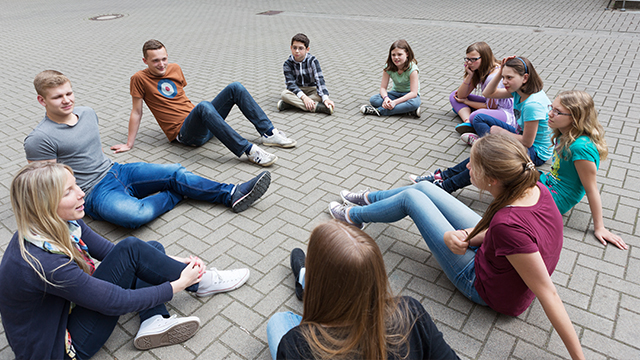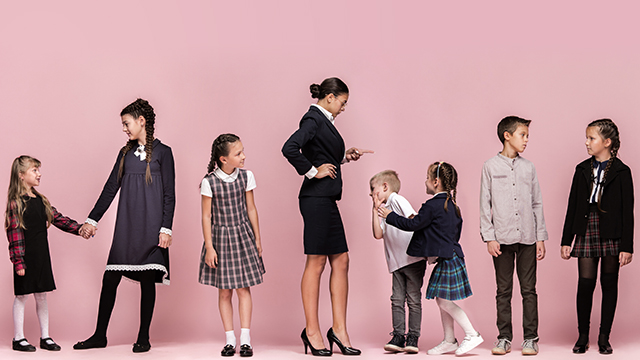10 of the Best Get to Know You Games for Theatre Classrooms
Written by Tiffany Wilkie
August 13, 2019
School is back in session, and it’s time to get to know your students. Use this list of ten activities to not only learn student’s names but to also begin the start of a relationship. Some of these ideas come from the teachings of the magnificent, Gai Jones. Remember building a safe environment for your students will help make every class feel like a united ensemble.
1. Connection Bingo

Students answer questions on a Bingo card and then go around and share their ideas. Have the students shout, “I feel connected” after they have completed five squares. Play may continue until all spaces are filled or when a time- limit is reached. Leave time at the end of class for students to share what they learned about one another.
2. Birthday Line-Up

Students must communicate their birth dates (month and day) nonverbally and form a straight line- standing in sequential numerical order. Indicate that January 1 is the beginning of the line and December 31 is the end of the line. Students should communicate using gestures but no speech. When students feel that they have completed the line in sequential order have them join hands and beginning with January 1, call out their birthdates. If a mistake is made, encourage the students to work together to fix it. Once the students have gotten into proper sequential order, the game is complete. Tell the students that you are proud of them for completing their first ensemble performance. Leave time at the end of class for students to share what they thought was difficult about the activity and what they liked about it.
3. The Group YES!

Ask the students to make a circle and then kneel. When ready, instruct the students to whisper “yes.” The students should repeat the word together and increasingly grow louder while rising from the kneeling position. Once all students are standing, all should exclaim “YES!” together and jump in the air. Congratulate the students for completing a positive ensemble building experience. Other words can be substituted for yes, like wow or yay.
4. Huggie Bear

Try this fun game of tag as an icebreaker to help students feel comfortable. Instruct the students to spread out around the stage or classroom. Call out “Huggie Bear” with various set group numbers like huggie bear 4, 5, 20, 10, 1, etc. Any student not in a hugging group has to sit down until you get down to two students, you then crown the two students the King and Queen of Huggie Beardom. t
5. Name Toss

This is a fun name game. Instruct students to make a circle and stand 6 inches apart. Explain that the students will toss a beanbag to one another. Before they throw the beanbag, they must make eye contact with someone and say that person’s name and then throw them the beanbag. When that person catches the beanbag, they say, “thank you, [actor’s name] who threw it to them and throw it to someone else. There are no outs, and it is not a competition. The only rule is students may not toss the ball to someone on their immediate left or right. The game continues until the set limit has ended. Once the game has finished, inform the students that the purpose of the game was more than to learn names. The students also learned to break down the barriers between one another and also to multitask.
6. The Rug is Lava

For this activity, you will need a rug that is at least two feet by four feet. Pick 6- 12 students to stand on the run together. Explain that the rug is on fire, and they need to work together silently to flip the rug over. The challenge is that the students cannot get off the rug, and their feet and hands may not touch the floor. Set a time limit of 8- 10 minutes. Once the first group has finished, discuss the concept of teamwork, miming communication, and raising the stakes. Ask the students why you chose to make the game nonverbal. After the discussion, congratulate the first group and have them choose a different group to go next.
7. Greet the Group

Invite students to sit in a circle. One student will be asked to stand and greet the entire group without speaking. The greeting should include only the upper part of the body and should express how they feel about the group. You may want to demonstrate by going first with something like, opening your arms wide and then closing them in on your heart to suggest you are welcoming the students into your soul. Have the group mimic what each student does for a greeting and then have the student pick the next person. Once all students have had a turn, discuss the concepts of awareness and acceptance of one another.
8. Part of a Whole

Instruct the students to think of objects or places that have many parts. An example might be a toolbox, one student calls out “toolbox,” and might hear students list items like a hammer, a tape measure, a pencil, a wrench, and so on. Other examples, include a library, Disney World, a car, etc. The purpose of this activity is to understand how it takes many parts to make a whole.
9. One to Ten

The aim of this activity is for the students to count as a group, yet individually, from 1 to 10. Invite the students to sit in a circle and close their eyes. Students should speak individually with no assigned number. Any student calls out number 1; then another calls out 2, then three and so on. If any two actors speak at the same time, the group must start over at number 1. Encourage the students to breathe and listen. Let the students know that it is more about creating group cohesiveness and teamwork; then it is about completing the goal.
10. Pass the Pulse

Pass the pulse is an excellent ensemble building activity to do with any group, especially at the end of a unit. Invite the students to stand in a circle and holding hands with the right palm facing down to send the pulse and the left palm facing up to receive the energy. Begin the activity by asking the students to close their eyes, then squeeze the person’s hand next to you and as each student gets the pulse, they quickly squeeze the hand of the person next to them, passing the pulse. Once the pulse has come back to you squeeze both hands while exclaiming something like “woohoo” while turning around until everyone is facing out and then bring everyone together for an all-hands in the middle cheer. You can say your school’s troupe number or really anything meaningful to your group.
Need some advice? We’ve got you covered.
- 10 Tips for Being a Positive Role Model in Your Theatre Community
- 5 Ways to Say “Thank You” to Your Cast and Crew
- 5 Character Development Techniques to Use in Rehearsals
- 5 Small Ways to Get Into (And Embrace) Your Character
- 5 Ways to Take Care of Yourself During Tech Week
- Devising Theatre: 7 Quick Tips for Your First Devising Project
- “I Can’t, I Have Rehearsal”: 5 Tips for Scheduling Your Life When You’re In Theatre
- How to Make Rehearsals A Warm and Welcoming Environment
- 10 Basic Rules of Stage Combat (That Keep Everyone Safe)
- 5 Advantages of Learning Stage Combat
- Theatre Artists on a Budget: How to Be Smart and Healthy While Pinching Pennies
- Productions on a Budget: Finding Props/Costumes/Set Dressings/Set Pieces Without Breaking the Bank
- 6 Steps to Memorizing Shakespeare
- 5 Helpful Tips for Attending Callbacks
- 10 Tricks to Staying Healthy All Season Long
- How to Balance Theatre and Coursework
- 10 Items Every Actor Should Carry in Their Rehearsal Bag
- 10 Items Every Dancer Should Keep in Their Rehearsal Bag
- Discover the Delightfully Nerdy World of Dramaturgy
